2021, Yorkshire Sculpture Park, UK
Silence
Timber, heather, string, 5 x 14 x 14 m
Commissioned by The Oak Project in partnership with Yorkshire Sculpture Park

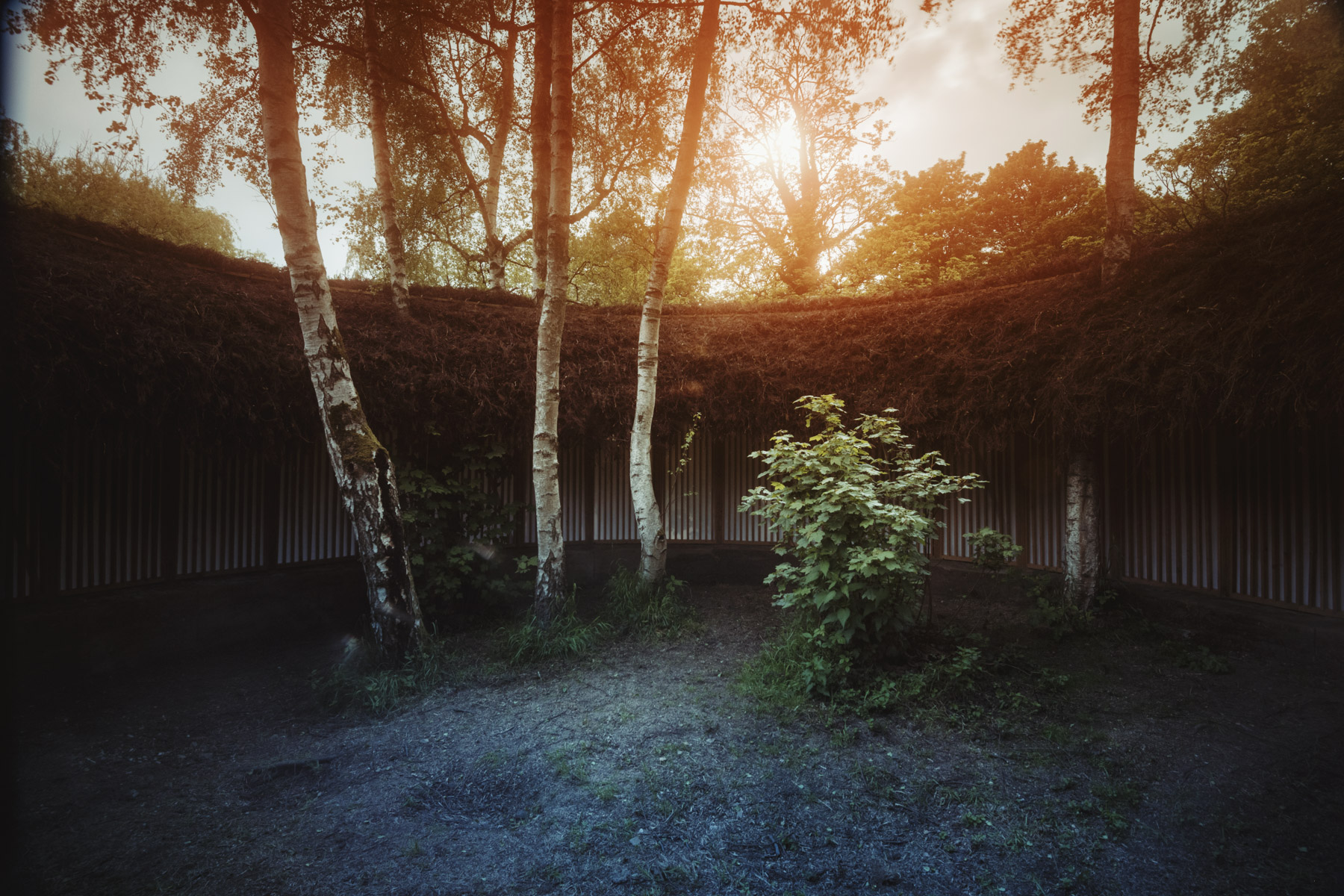












Silence – Alone in a World of Wounds was unveiled at Yorkshire Sculpture Park on World Environment Day on 5 June 2021. It is a sculptural space made of natural materials, including timber and thatch, that acts as an extended open pavilion with passageways and a chamber providing space for quiet reflection and connection to the natural world. To discover the inner passageway, the visitor must first circle the structure, walking mindfully beneath the overhang of thatched roof. Once inside, a series of staggered doorways gradually lead one along a contemplative cloister-like path to its heart. Views to the central space are screened by paper walls, and turf is visible above as an underlay to the thatch. Its inwardly sloping roof, blanketed with twenty-five tonnes of fragrant, hand-tied heather, intensifies the noiselessness as one walks. The central chamber encircles a ring of fourteen silver birches. There are two seating areas for contemplation: one around the exterior perimeter and another inside, sheltered by the overhanging eaves.
Informed by research evidence from the Nature Connectedness Research Group at the University of Derby, the work is a circle, set within nature, and a place for silence, creating an area of calm contemplation. Silence invites us to stop and connect, to consider and experience and to listen to our natural surroundings.
Informed by research evidence from the Nature Connectedness Research Group at the University of Derby, the work is a circle, set within nature, and a place for silence, creating an area of calm contemplation. Silence invites us to stop and connect, to consider and experience and to listen to our natural surroundings.
The idea of creating a place for silence has a dual meaning. As well as being silent, there is the idea that the natural world is itself becoming more silent due to the effects of climate change. The work is constructed from sustainable materials within the West Bretton estate at YSP, including local timber, hand-tied heather, and compressed earth. It will degrade naturally over a period of years, becoming a habitat for wildlife and slowly returning to the earth, leaving only a faint imprint on the landscape. ‘In time, there will be just two concentric circles left’, says Ivan Morison. With its gradual deterioration, the structure fits with the artists’ long-held interest in ruins. ‘We think of our work as ruins for the future. They’re incomplete. They have a function that you can’t quite put your finger on’, says Ivan.
In many ways, Silence embodies the Morisons’ sustained efforts, now stretching more than fifteen years, to transcend the division between art and architecture, as well as their mission to bring meaning, beauty, and purpose into everyday life, to connect people with each other and with their surroundings. To create, in other words, a new relationship with nature.
‘Silence is an exceptional sculpture, forged from earth, timber, paper, and living trees. Holding light, space, and stillness, it is a place of peace, an oasis of calm in which people will be inspired, moved, and rejuvenated. Joining other works of land art at Yorkshire Sculpture Park by James Turrell, Andy Goldsworthy, and David Nash –
as well as the natural tree canopies that form spiritual spaces in the park – Heather Peak and Ivan Morison’s work contributes to the canon of sculpture in the open air, which now more than ever is so relevant and meaningful.’
Clare Lilley, Director, Yorkshire Sculpture Park
In many ways, Silence embodies the Morisons’ sustained efforts, now stretching more than fifteen years, to transcend the division between art and architecture, as well as their mission to bring meaning, beauty, and purpose into everyday life, to connect people with each other and with their surroundings. To create, in other words, a new relationship with nature.
‘Silence is an exceptional sculpture, forged from earth, timber, paper, and living trees. Holding light, space, and stillness, it is a place of peace, an oasis of calm in which people will be inspired, moved, and rejuvenated. Joining other works of land art at Yorkshire Sculpture Park by James Turrell, Andy Goldsworthy, and David Nash –
as well as the natural tree canopies that form spiritual spaces in the park – Heather Peak and Ivan Morison’s work contributes to the canon of sculpture in the open air, which now more than ever is so relevant and meaningful.’
Clare Lilley, Director, Yorkshire Sculpture Park
Photographers’ credits
Installation images_ Charles Emerson
Installation images_ Charles Emerson
2021-, Various locations, UK
Small Bells Ring
Steel narrowboat, timber, fixtures, and library of books
Registered in Accrington, Lancashire
Co-commissioned by Super Slow Way, Coventry City of Culture Trust, and Arts Council England, in collaboration with Lancashire and Coventry Library Services and their communities, Canal & River Trust, and British Council

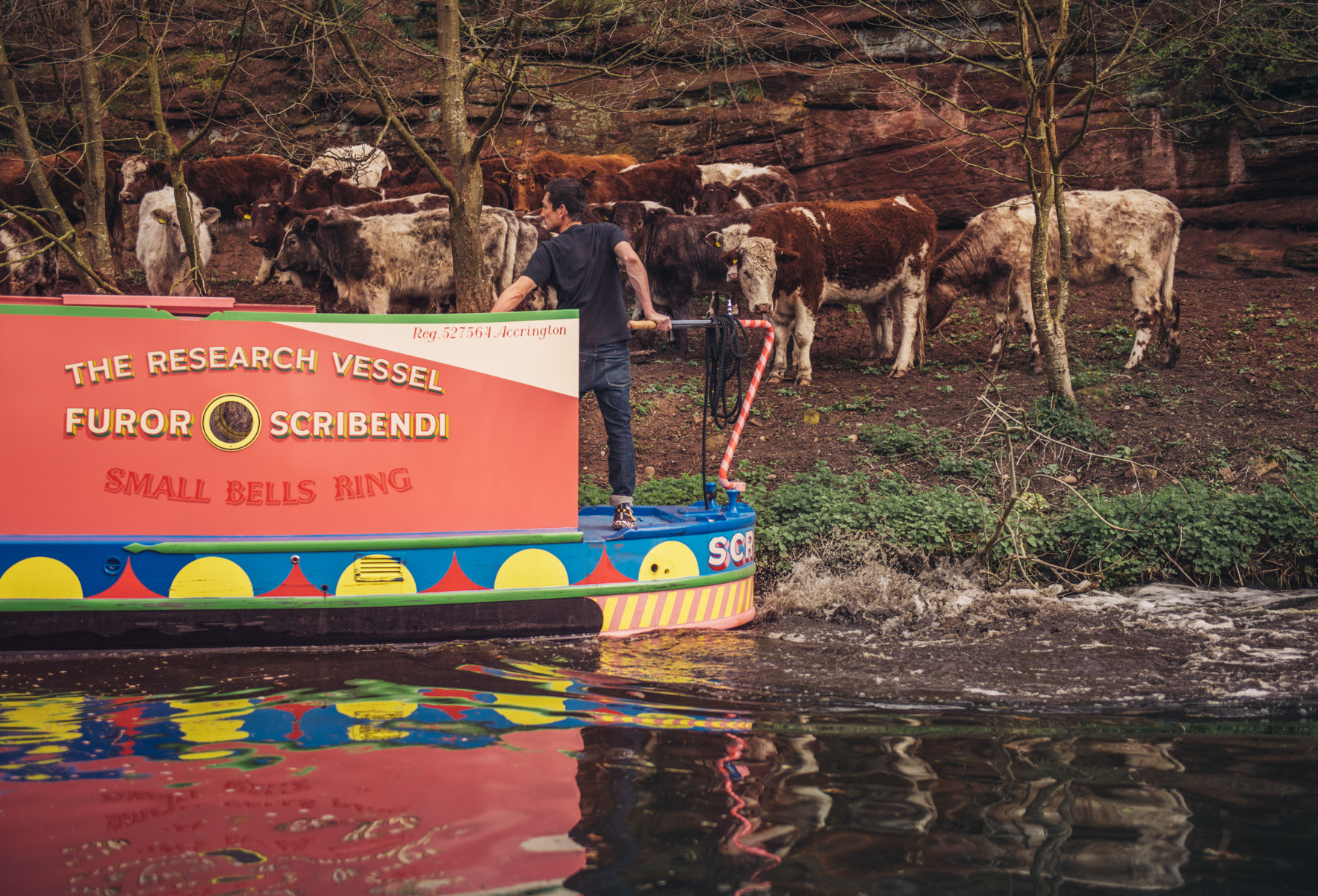





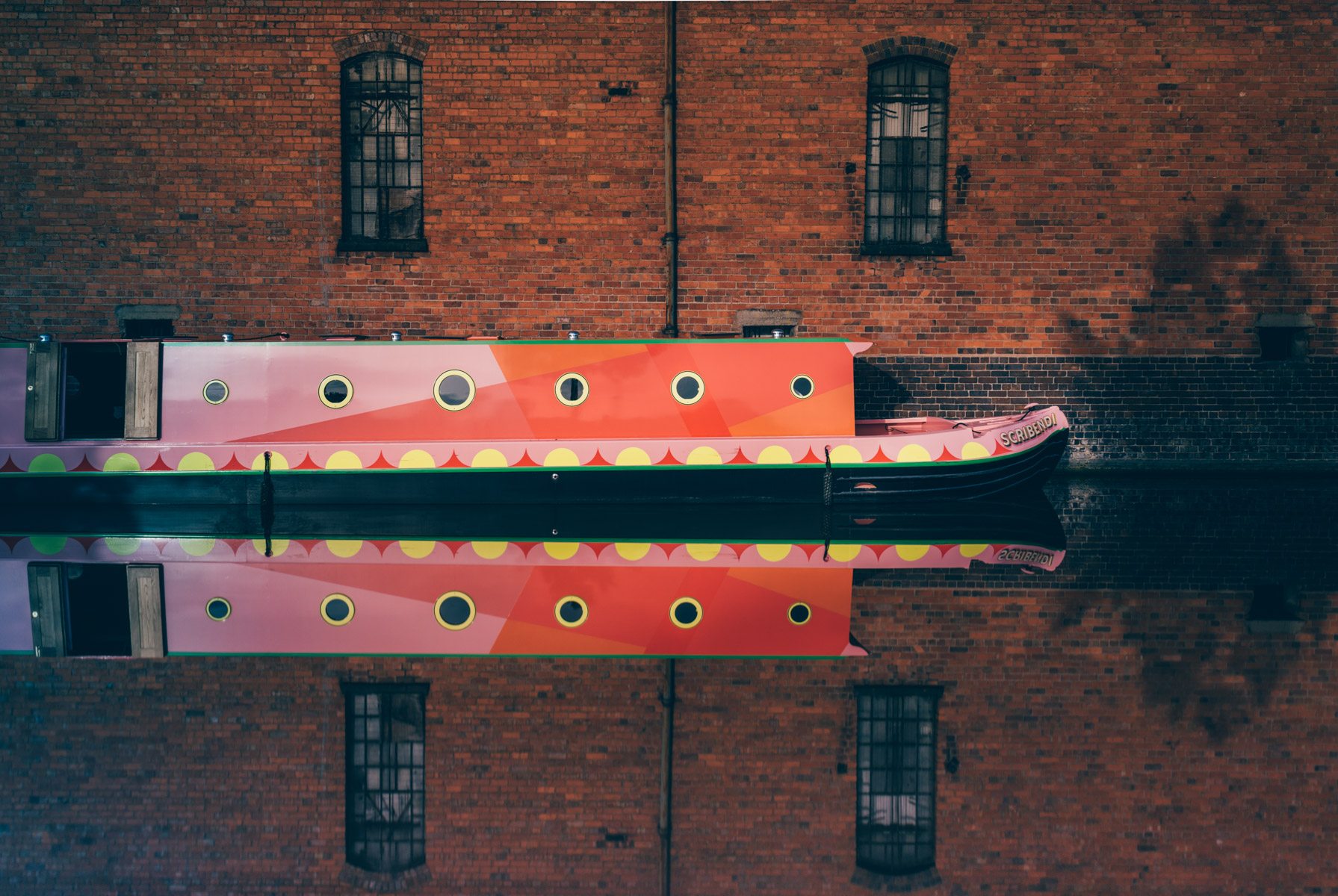

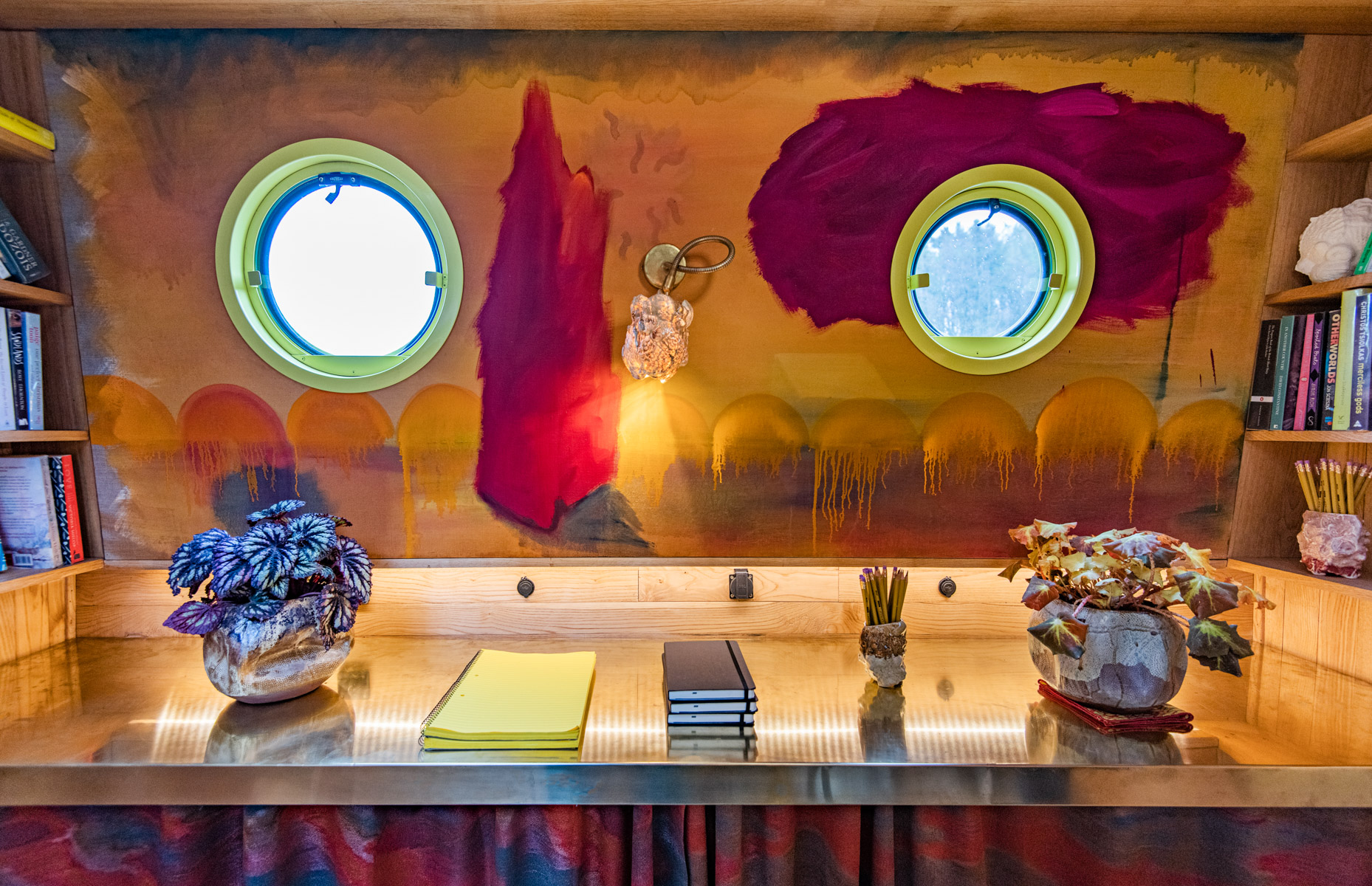




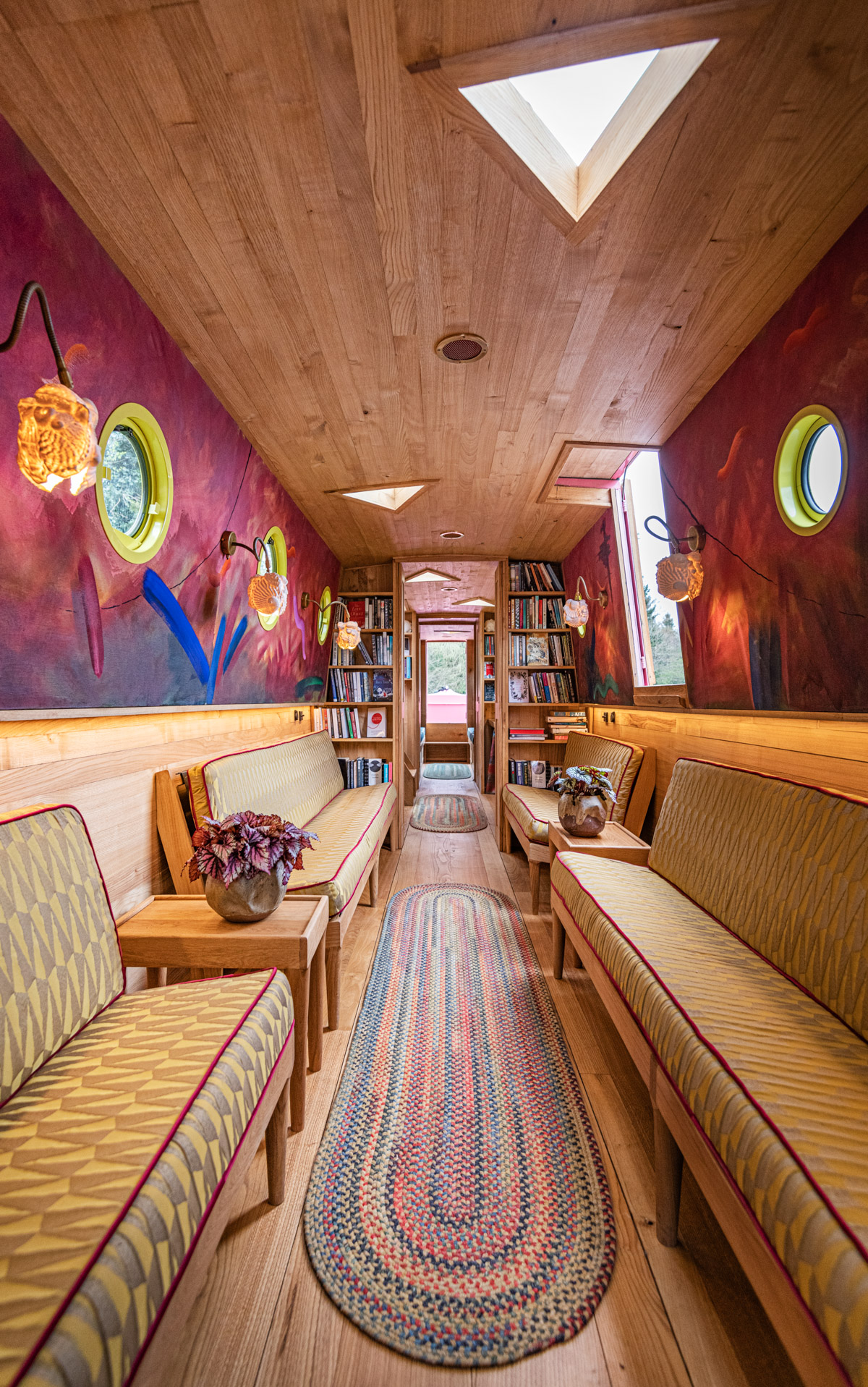

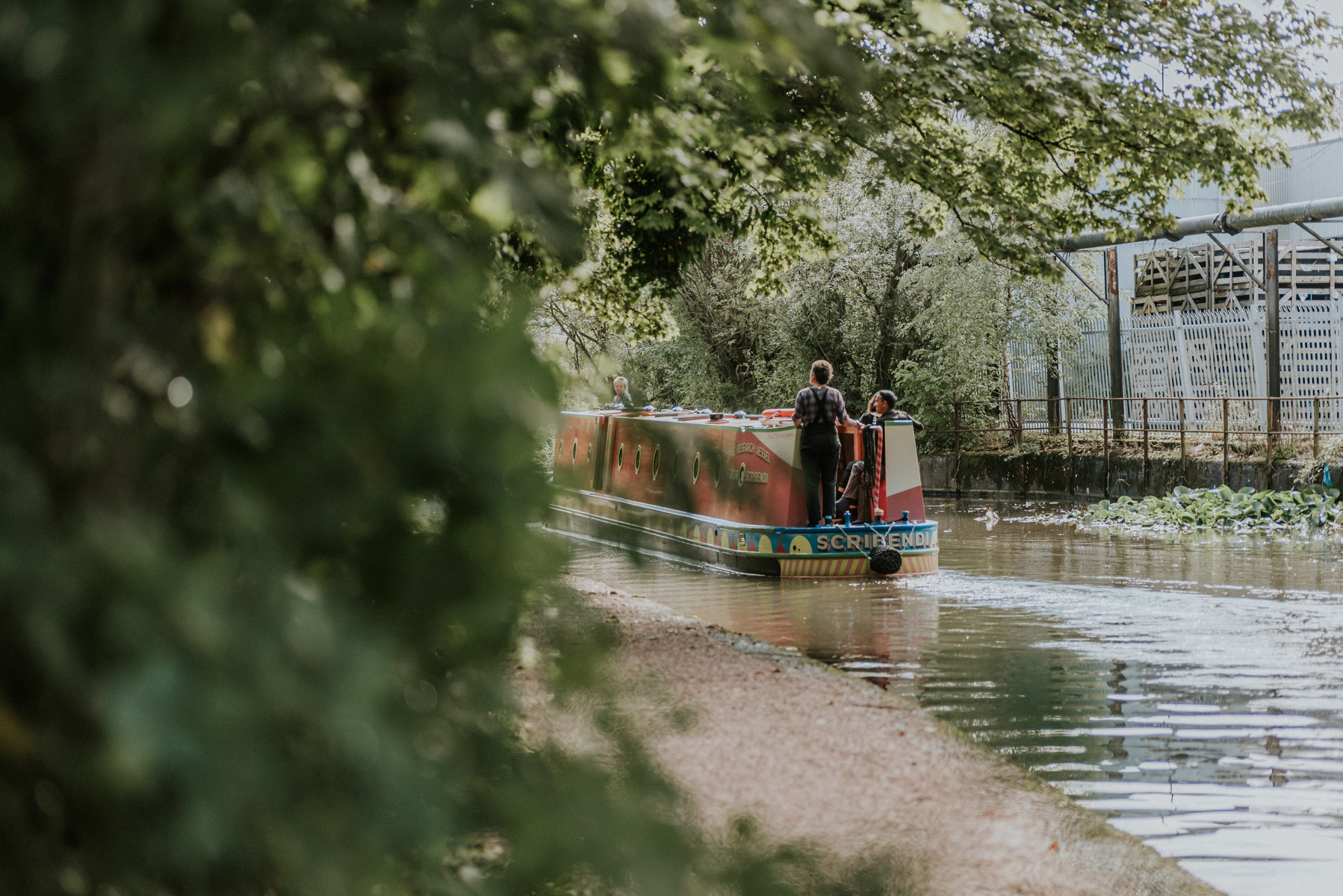







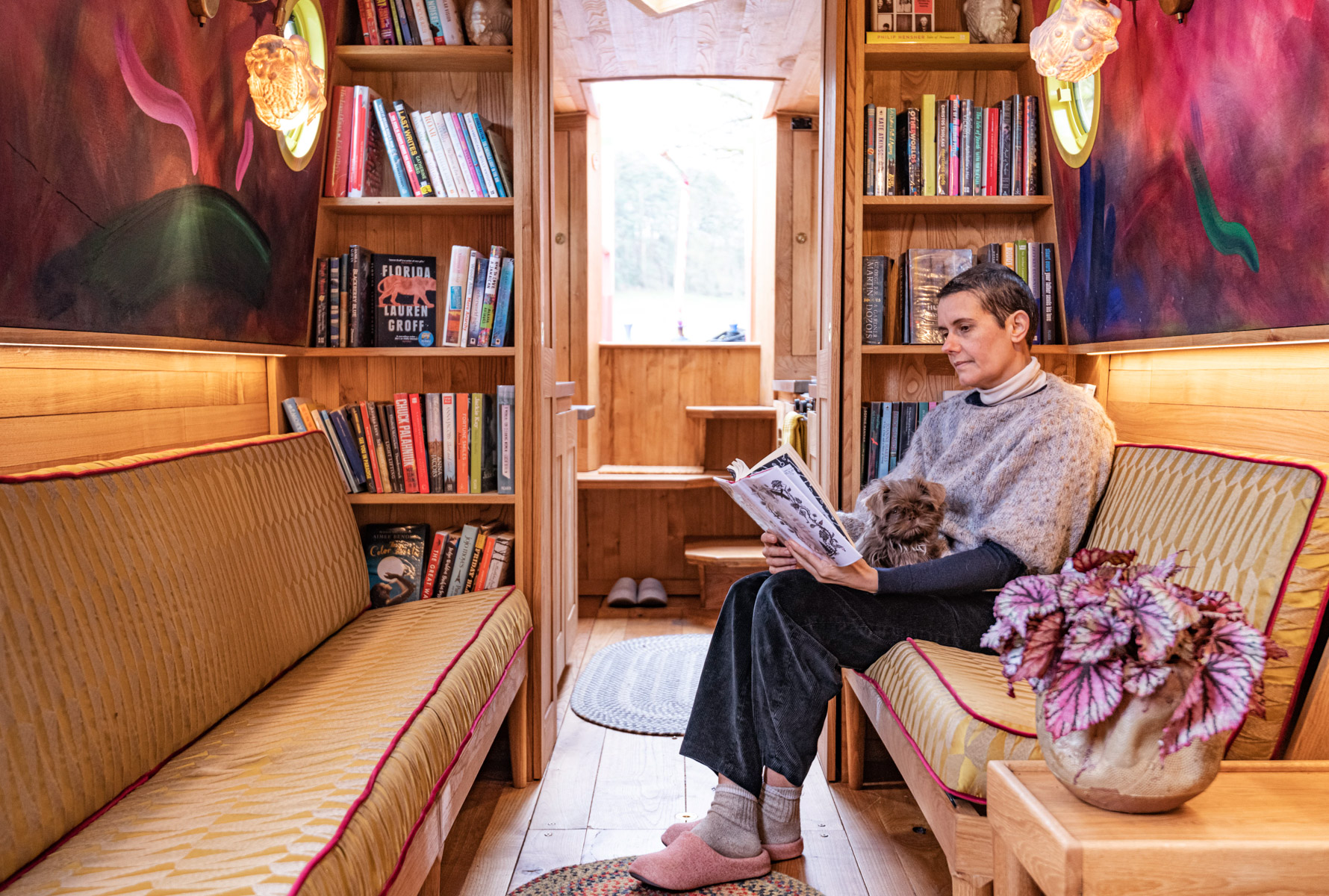



Small Bells Ring is an artwork centred on the RV Furor Scribendi, a fully functioning sculptural narrowboat that operates as a living research vessel, housing a floating public library of short stories and a retreat for writers and readers. The boat cruises the canals of Lancashire, Manchester, Macclesfield, and Stoke-on-Trent. It also spent the summer of 2021 in Coventry as part of its City of Culture year, before returning to east Lancashire for that year’s British Textile Biennial.
Two books were the seeds from which the work grew. The first was Oranges Are Not The Only Fruit by Jeannette Winterson, a semi-autobiographical story of Pentecostal religion, literature, and lesbian love set in Accrington, Lancashire, that left a lasting impression on Heather Peak when she saw the BBC’s adaptation broadcast in 1990. The second inspiration was Stanley Crawford’s 1972 allegorical tale The Log of the SS the Mrs Unguentine, a novel written in the form of a ship’s log, albeit one lacking dates, times, or coordinates. The Morisons’ project is a collaboration with the librarians of Accrington Library, a Carnegie library that opened in 1908, where the phrases ‘Knowledge is Power’ and ‘Oh, For a Book and a Cosy Nook’ are written in the very fabric of the building.
Two books were the seeds from which the work grew. The first was Oranges Are Not The Only Fruit by Jeannette Winterson, a semi-autobiographical story of Pentecostal religion, literature, and lesbian love set in Accrington, Lancashire, that left a lasting impression on Heather Peak when she saw the BBC’s adaptation broadcast in 1990. The second inspiration was Stanley Crawford’s 1972 allegorical tale The Log of the SS the Mrs Unguentine, a novel written in the form of a ship’s log, albeit one lacking dates, times, or coordinates. The Morisons’ project is a collaboration with the librarians of Accrington Library, a Carnegie library that opened in 1908, where the phrases ‘Knowledge is Power’ and ‘Oh, For a Book and a Cosy Nook’ are written in the very fabric of the building.
The steel hull of the boat was fabricated to the artists’ design by a third-generation boat builder in Stoke-on-Trent, with the exterior done by a specialist boat painter. The interior was fitted out by the artists and their team, incorporating specially milled local oak and chestnut, a series of new oil paintings by the artists, new seating and upholstery, a set of new ceramic lights cast from items found floating in the canals, and many bookshelves for the collection of around a thousand books. ‘I chose the short story as the conduit for this commission and the boat as its vehicle’, Heather Peak explains. ‘The librarians and I have defined it as a story you can read in one sitting. The reader can decide on how long a sitting is, it could be all day, but the point is to stop and read.’
As well as the library, the RV Furor Scribendi contains a fully equipped galley, a writers’ room, a bathroom, a reading salon, room for twelve passengers, and overnight accommodation for two people. Its name takes inspiration from an essay by Octavia E. Butler, who translates the Latin term as ‘a rage for writing’. The prefix RV stands for ‘research vessel’, as the boat hosts a series of writers-in-residence and conducts research, publishing its findings regularly via an online ship’s log.
‘Literature is a thread that runs through our practice, from making whole shows about certain books through to our titles, which often have a literary reference. Literature appears continuously as a place to grow ideas from or to rub against. I like surrounding myself with books, because they have the answers to everything. When I read books, I feel better. I find them comforting and enriching and warming.’
Heather Peak
As well as the library, the RV Furor Scribendi contains a fully equipped galley, a writers’ room, a bathroom, a reading salon, room for twelve passengers, and overnight accommodation for two people. Its name takes inspiration from an essay by Octavia E. Butler, who translates the Latin term as ‘a rage for writing’. The prefix RV stands for ‘research vessel’, as the boat hosts a series of writers-in-residence and conducts research, publishing its findings regularly via an online ship’s log.
‘Literature is a thread that runs through our practice, from making whole shows about certain books through to our titles, which often have a literary reference. Literature appears continuously as a place to grow ideas from or to rub against. I like surrounding myself with books, because they have the answers to everything. When I read books, I feel better. I find them comforting and enriching and warming.’
Heather Peak
Photographers’ credits
Exterior and interior shots_ Charles Emerson / People shots_Sinead Patching
Exterior and interior shots_ Charles Emerson / People shots_Sinead Patching
2020, Surrey, Canada
The Moment
Steel, 6.8 x 4.9 x 3.9 m
Commissioned by the City of Surrey, British Columbia, Canada



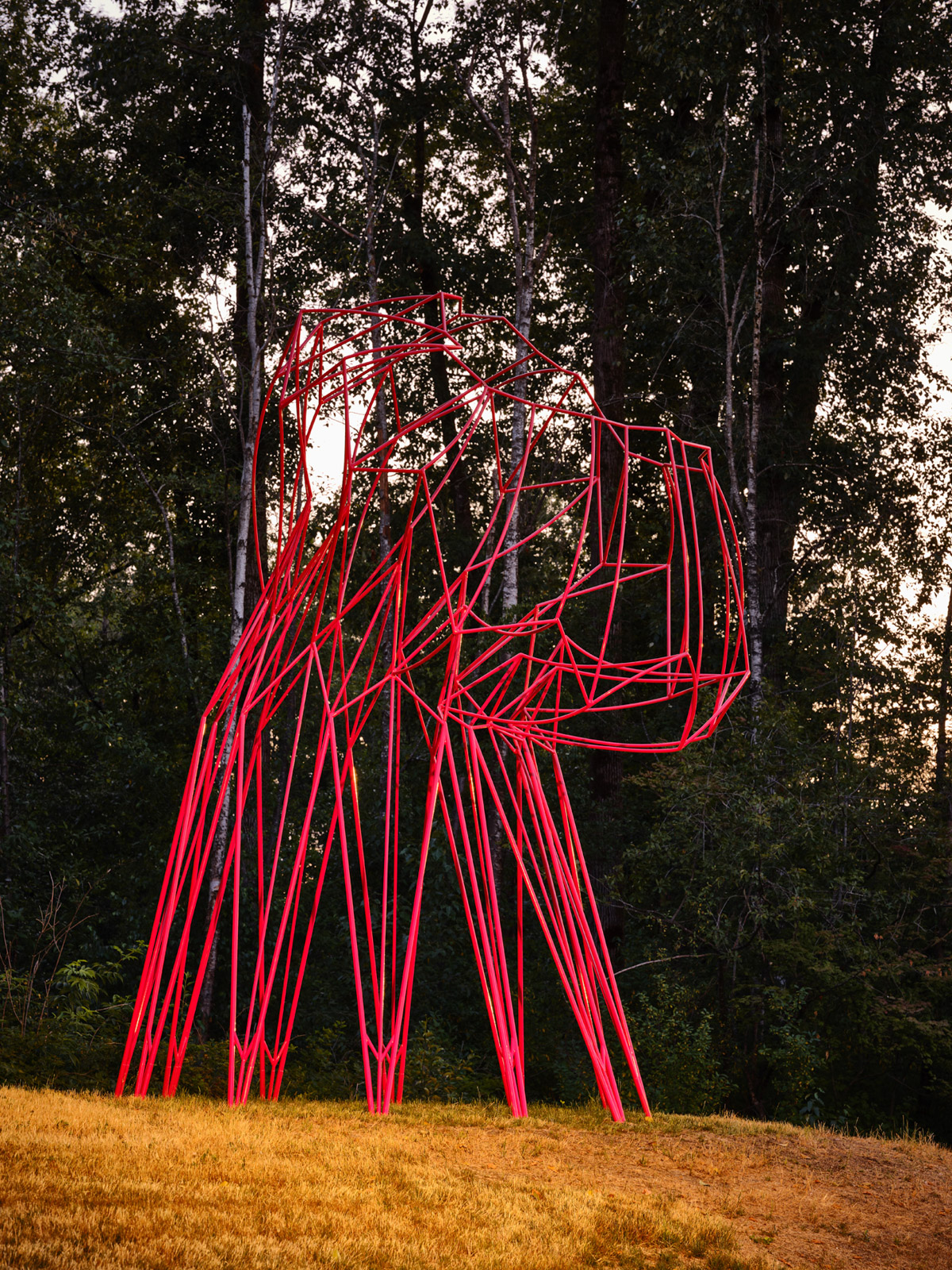

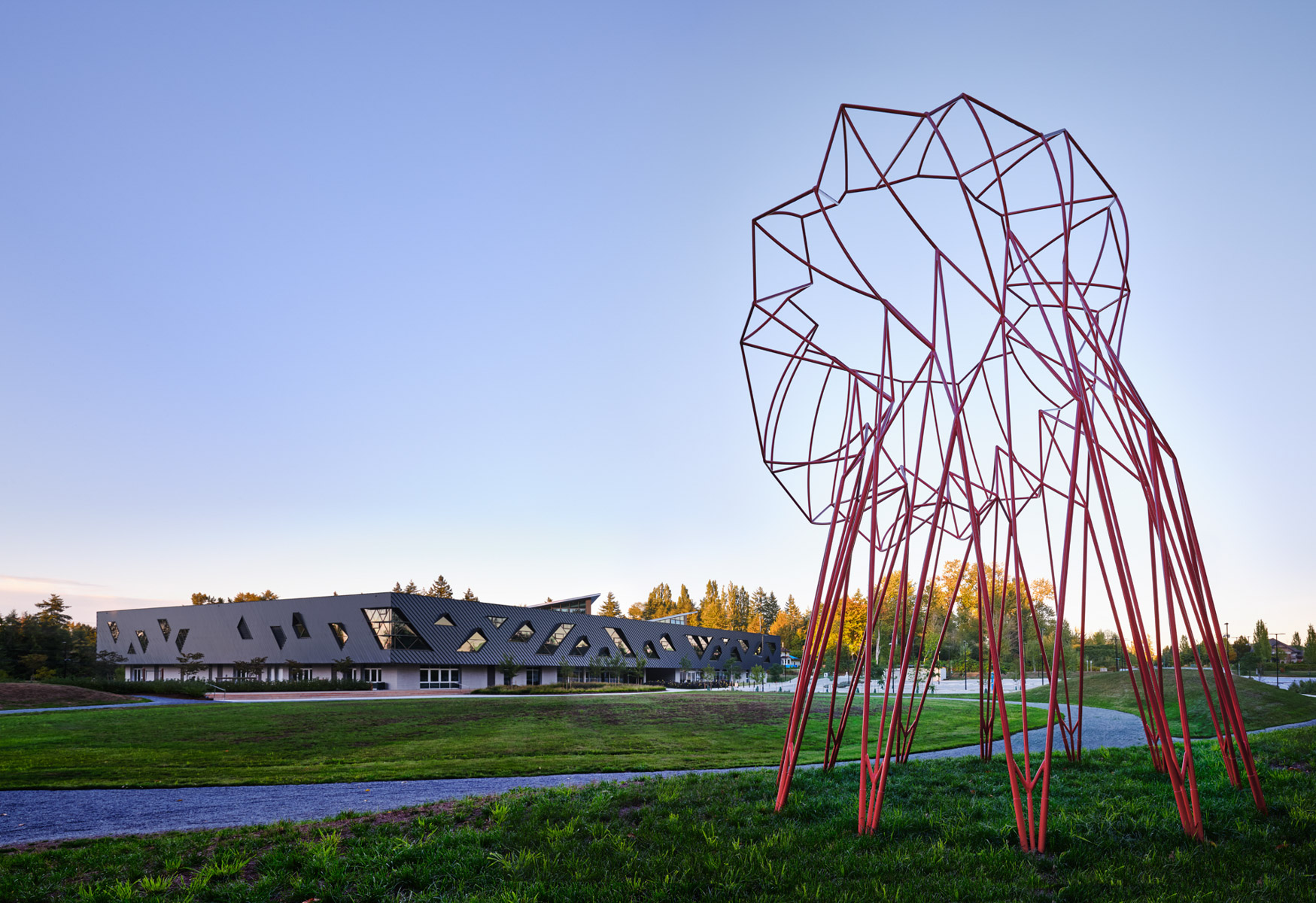

In early 2018, Heather Peak and Ivan Morison spent three months of research and community engagement with three hundred residents from Clayton in Surrey, Canada. Locals of all ages and backgrounds shared their reflections on their neighbourhood, as well as their aspirations for a public artwork to capture the place they call home. The process culminated in a second Impossible Rainbow Dinner, this time at a local school. The artists collaborated with students to make crockery from moulds of an old softball and deflated basketball found on the site of the future Clayton Community Centre. They turned these discarded objects into something functional and beautiful, demonstrating the power of art to transform our everyday lives. Sixty-five people from the neighbourhood came to the dinner, attendees giving feedback about the future artwork. One wrote, ‘Please make something to bring us together like this.’
That is just what The Moment is about – bringing people together in a shared space, allowing for different levels of engagement and creating an open form that can be transformed in multiple and unexpected ways. Made of steel and standing over six metres tall, the work alludes to gathering spaces like pavilions, bandstands, and agoras. Comprised of straight and curved lines coloured a bright raspberry to stand out against the trees, it is a frame in which anything can happen. It is a place to make art, meet friends, and transform for events. It could be draped with fabric to provide a summer reading space, strung with garlands for an open-mic music evening, or transformed with lights into a glowing lantern. In short, it is a place for the community to make meaningful moments of their own.
The form itself invites the question ‘what is it?’ The artists say, ‘As you move around and within the piece, it continually reveals and confuses its own form, alive and full of potentiality.’ From each angle, a different interpretation emerges: a net, a web, a flower turning its head to the sun, a make-believe creature waiting to play with a friend, a tower leaning over to listen to the people below. It is an outline to ‘colour in’, inviting the community to fill it with their own imaginations.
The title comes from a Margaret Atwood poem of the same name that questions individual ownership of one’s natural surroundings and speaks to the concept of ‘the commons’
at the heart of the Clayton Community Centre and civic life in general. At a time of increasingly privatized land, how do we hold a space in common that everybody can use and enjoy?
That is just what The Moment is about – bringing people together in a shared space, allowing for different levels of engagement and creating an open form that can be transformed in multiple and unexpected ways. Made of steel and standing over six metres tall, the work alludes to gathering spaces like pavilions, bandstands, and agoras. Comprised of straight and curved lines coloured a bright raspberry to stand out against the trees, it is a frame in which anything can happen. It is a place to make art, meet friends, and transform for events. It could be draped with fabric to provide a summer reading space, strung with garlands for an open-mic music evening, or transformed with lights into a glowing lantern. In short, it is a place for the community to make meaningful moments of their own.
The form itself invites the question ‘what is it?’ The artists say, ‘As you move around and within the piece, it continually reveals and confuses its own form, alive and full of potentiality.’ From each angle, a different interpretation emerges: a net, a web, a flower turning its head to the sun, a make-believe creature waiting to play with a friend, a tower leaning over to listen to the people below. It is an outline to ‘colour in’, inviting the community to fill it with their own imaginations.
The title comes from a Margaret Atwood poem of the same name that questions individual ownership of one’s natural surroundings and speaks to the concept of ‘the commons’
at the heart of the Clayton Community Centre and civic life in general. At a time of increasingly privatized land, how do we hold a space in common that everybody can use and enjoy?
‘On our first visit to the site, we saw the sharp crisscross of bare branches in the sky, and at our feet the geometry of forming ice crystals. In our minds were creeping vines and skeletal pagodas from Venice, the volume within the curving ribcage of a blue whale, the bent frames of early local shelters, a cow carcass hung from a tree in the yard of our studio this past year changing, slumping slowly as time passes. Straight lines, curved lines, lines that define a form no longer present, or still to be. These were our starting points for this artwork.
A trope at the centre of our work is a simple action repeated. In this case, we began with a fold, repeated twenty-four times to create a pleated surface. To this, we applied V-folds, the action of which changes the direction of the pleat, introducing movement. This pleated and folded form is drawn around on itself, creating geometric structural form.
The pleating and folding is repeated and repeated in paper many times, generating multiple prototypes. One is selected, it is made solid, and a complex plaster mould is taken. A clay slipcast form is created, sanded, fired. The kiln is set very high, the ceramics vitrify, melt, and slump in
the kiln. The heat is extraordinary, the process elemental. The only influence we can have is the original form and the thickness of the clay walls we have created. Time and again, we cast more forms, fire them, wait and wait for them to cool to see the results.
Finally, we arrive at a form that offers the characteristics we are looking for, that embodies the movement of the naked branches, the perfection of the ice, the volume of a whale, the shelter of the early bent frames, the passage of time, captured in a single moment. Now the slumped ceramic form is 3D-scanned and translated into digital form. On screen, its facets are removed and it is reduced down to its own skeleton, some parts still strongly geometric, others more organic, curving, and sagging. The frame is engineered, steel rod weights calculated, a colour chosen – raspberry – and it is sized to the scale of a whale, an iconic sculpture, a pavilion, with a strong sense of gathering, of celebration.’
Ivan Morison
A trope at the centre of our work is a simple action repeated. In this case, we began with a fold, repeated twenty-four times to create a pleated surface. To this, we applied V-folds, the action of which changes the direction of the pleat, introducing movement. This pleated and folded form is drawn around on itself, creating geometric structural form.
The pleating and folding is repeated and repeated in paper many times, generating multiple prototypes. One is selected, it is made solid, and a complex plaster mould is taken. A clay slipcast form is created, sanded, fired. The kiln is set very high, the ceramics vitrify, melt, and slump in
the kiln. The heat is extraordinary, the process elemental. The only influence we can have is the original form and the thickness of the clay walls we have created. Time and again, we cast more forms, fire them, wait and wait for them to cool to see the results.
Finally, we arrive at a form that offers the characteristics we are looking for, that embodies the movement of the naked branches, the perfection of the ice, the volume of a whale, the shelter of the early bent frames, the passage of time, captured in a single moment. Now the slumped ceramic form is 3D-scanned and translated into digital form. On screen, its facets are removed and it is reduced down to its own skeleton, some parts still strongly geometric, others more organic, curving, and sagging. The frame is engineered, steel rod weights calculated, a colour chosen – raspberry – and it is sized to the scale of a whale, an iconic sculpture, a pavilion, with a strong sense of gathering, of celebration.’
Ivan Morison
Photographers’ credits
All’s Well that Ends_ Ivan Morison
All’s Well that Ends_ Ivan Morison
2019, Cambridgeshire, UK
Mother…
Straw, timber, string, 9.5 x 8.5 x 8.5 m
Commissioned by Wysing Arts Centre for ‘New Geographies’
Supported by Arts Council England and the National Trust






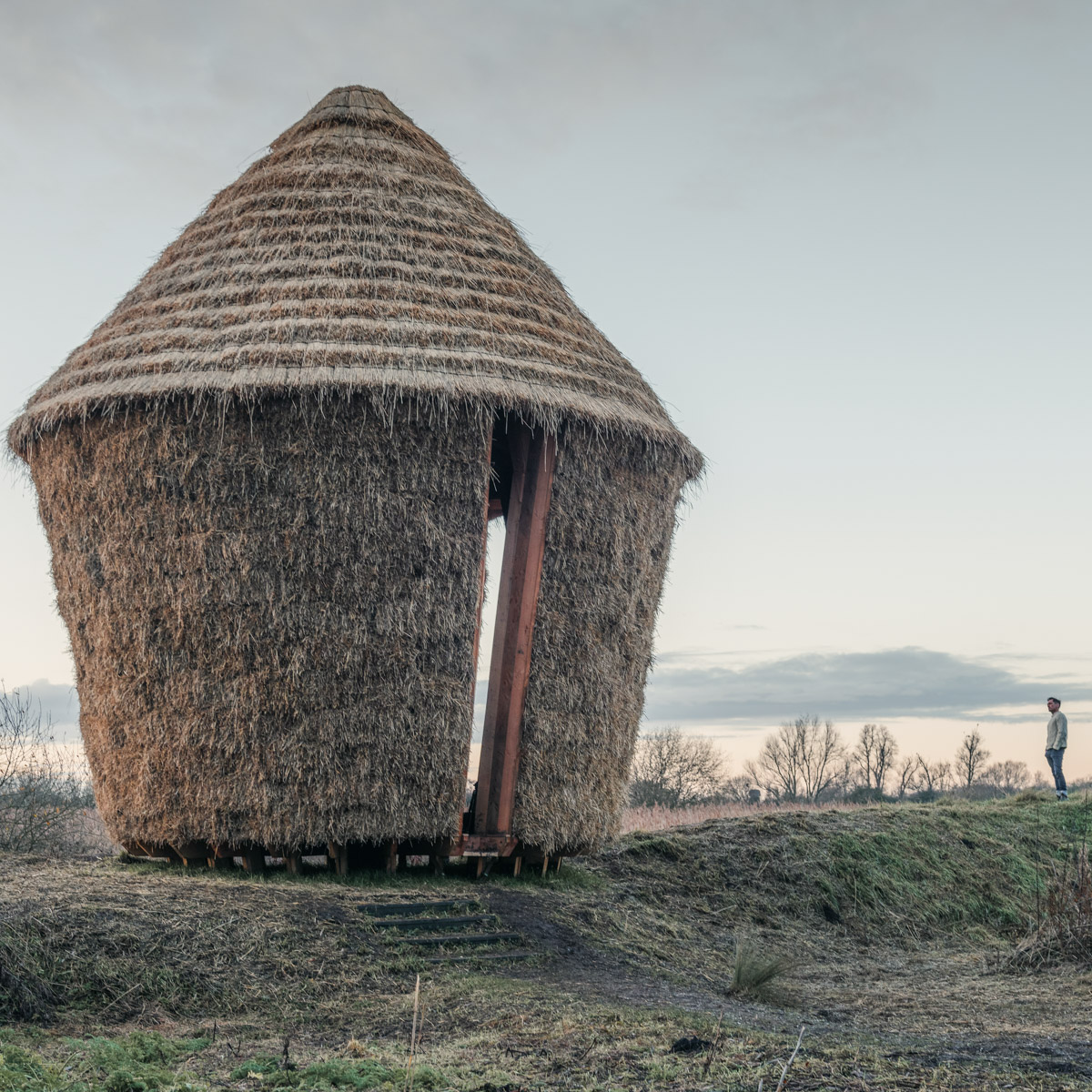




MOTHER … is an artwork that engages with the connections between the natural world and our mental health. It was inspired by Richard Mabey’s memoir Nature Cure, in which he describes recovering from severe depression through walking, watching, and writing about the landscapes of eastern England. The sculpture was commissioned by the late Donna Lynas, director of nearby Wysing Arts Centre, as part of ‘New Geographies’, which brought contemporary art to unexpected places in the region. All the locations were nominated by the public. In this case, the Wicken Fen Nature Reserve in Cambridgeshire was suggested for its ‘sublime peaty landscape’.
MOTHER … references local building traditions, materials, and architectural vernacular to root the structure in its landscape. The form is an interpretation of the hayricks once found dotting this countryside. The timber used in the framing was felled from the artists’ own forest in Wales and milled by them at their workshops. The walls and roof are made from local straw, the thatching of which has been done in the traditional style by a master thatcher whose first job as an apprentice was to thatch a hayrick on this very site. The work, with its deep entranceways, ceiling oculus, and high double-layered conical ceiling, is an architectural space to enter, altering one’s experience of the surrounding landscape, sky, light, and materials. As Ivan Morison says, ‘You sit on one of its twenty-seven seats with the straw at your back, breathing in the natural smells of wood, straw, and wildlife. Owls are nesting in it – it’s beautiful to see them swooping in and out. The doorways are very long and narrow, reframing the view of the overwhelmingly horizontal landscape. We hope it’s a way for people to appreciate the natural environment anew.’
MOTHER … references local building traditions, materials, and architectural vernacular to root the structure in its landscape. The form is an interpretation of the hayricks once found dotting this countryside. The timber used in the framing was felled from the artists’ own forest in Wales and milled by them at their workshops. The walls and roof are made from local straw, the thatching of which has been done in the traditional style by a master thatcher whose first job as an apprentice was to thatch a hayrick on this very site. The work, with its deep entranceways, ceiling oculus, and high double-layered conical ceiling, is an architectural space to enter, altering one’s experience of the surrounding landscape, sky, light, and materials. As Ivan Morison says, ‘You sit on one of its twenty-seven seats with the straw at your back, breathing in the natural smells of wood, straw, and wildlife. Owls are nesting in it – it’s beautiful to see them swooping in and out. The doorways are very long and narrow, reframing the view of the overwhelmingly horizontal landscape. We hope it’s a way for people to appreciate the natural environment anew.’
The vessel-like form of the shelter, alongside its title, connotes universal ideas of protection, nurturing, and birth. For Heather Peak, the work suggests protection of another kind too. ‘I have depression. I am well at the moment, but I know that, when I am ill, being outside and having somewhere to shelter and sit is very useful. MOTHER … means to be soothing and restful, but also acknowledges the anger, frustration, and sheer terror that can be the mind. You cannot get away from your head. MOTHER … is like another head to step inside for a short while, with her own space, smell, form, and light. She is meant to be strong, wise, and compassionate, which is what I need when I am poorly.’
‘Such is the Morisons’ sensitivity to place and materials, the work, with its evocative and timeless shape, sits within the haunting landscape of Wicken Fen as though it had always been there. It is the artists’ intention that the work, tucked away in a remote part of the site, is encountered within the silence of the fen, offering solace and refuge to those who wish to sit within it – the structure can be entered through three doors around its perimeter. MOTHER … conjures up the ghosts of fen hayricks, from which it takes its shape, and both takes us back in time to another era when the shape would have been a familiar one to this region whilst also reminding us that in the current present, it is important to find moments of silence and solitude.’
Donna Lynas, late director, Wysing Arts Centre
‘Such is the Morisons’ sensitivity to place and materials, the work, with its evocative and timeless shape, sits within the haunting landscape of Wicken Fen as though it had always been there. It is the artists’ intention that the work, tucked away in a remote part of the site, is encountered within the silence of the fen, offering solace and refuge to those who wish to sit within it – the structure can be entered through three doors around its perimeter. MOTHER … conjures up the ghosts of fen hayricks, from which it takes its shape, and both takes us back in time to another era when the shape would have been a familiar one to this region whilst also reminding us that in the current present, it is important to find moments of silence and solitude.’
Donna Lynas, late director, Wysing Arts Centre
Photographers’ credits
Installation images_Charles Emerson / Performance_Stephen King
Installation images_Charles Emerson / Performance_Stephen King
2019, London, UK
Seafood Disco
Concrete and aggregates and cast iron,
overall 0.9 x 5 x 28 m, barbecues 0.9 x 0.7 x 0.7 m
Commissioned by NOW Gallery for Greenwich Peninsula















Seafood Disco is a long, gently curving sixty-seater picnic bench beside the River Thames in the shape of a smile. At twenty-seven metres in length, it is the longest picnic table in London. The work began in the studio with a bag of coconuts and the old Tommy Cooper joke, ‘I went to a seafood disco – and pulled a muscle.’ The coconuts led to a playful form built from the fundamental geometries of the cone, cylinder, and slab, with the recurring funfair motif of the hemispherical half coconut propping up stools and popping up through tabletops. Cooper’s joke connects the river and the pearlescent mussel shells set within the unique terrazzo surface of the table and bench surfaces, as well as giving the table its joyful smile.
The work also includes four permanently installed barbecues that can be used by anyone, creating a green space for people to gather, cook, and eat together, while enjoying views of the river up past the Emirates Air Line cable car and down to the Thames Barrier. Jemima Burrill, who commissioned the work, explained why she was drawn to the Morisons’ practice. ‘They marry an aesthetic gorgeousness with an essential function: a place to eat. They make designs for people. The key thing about this picnic bench is that it an exceptional, extraordinary design but something that people can enjoy. It will bring people to the area and make them smile, this giant smile formed out of concrete, but it is also totally practical. People can come on their own or with friends and sit and eat or watch the sun set in a wonderful place that has been created by a beautifully designed bit of concrete.’
The work also includes four permanently installed barbecues that can be used by anyone, creating a green space for people to gather, cook, and eat together, while enjoying views of the river up past the Emirates Air Line cable car and down to the Thames Barrier. Jemima Burrill, who commissioned the work, explained why she was drawn to the Morisons’ practice. ‘They marry an aesthetic gorgeousness with an essential function: a place to eat. They make designs for people. The key thing about this picnic bench is that it an exceptional, extraordinary design but something that people can enjoy. It will bring people to the area and make them smile, this giant smile formed out of concrete, but it is also totally practical. People can come on their own or with friends and sit and eat or watch the sun set in a wonderful place that has been created by a beautifully designed bit of concrete.’
For Ivan Morison, it is the attention to the detail of the materials that elevates the work. ‘We could have made the same object with the same form as you approach it, but it is when you sit down and use it, and you notice the details, and feel the different textures, and see the light hit the surfaces, that is when the experience is amplified. You know that every detail has been thought about. Sometimes those details are more important and powerful than the big-picture stuff.’
‘The Morisons are two people who can create sculpture in an innovative and magical way.
This work perches perfectly in its environment, as if it had always been there, considered and thoughtful. Their sixty-seater table Seafood Disco with its barbecues for all to use, designed to sit in a perfect spot on Greenwich Peninsula, carves out a curve so locals can sit and watch Thames life. This useable sculpture makes a moment for people to talk to each other and interact, while enjoying the glimmering water rushing to the Thames Barrier. Lest we forget their humour around the making of a work, which colours an idea and brings awe and gladness to any project. Plus their attention to materiality: the table’s surface glimmering with glass and shells, a surface so delicious, created for people’s enjoyment. Heather and Ivan imagine other possibilities, and I am glad.’
Jemima Burrill, cultural consultant and curator, NOW Gallery
‘The Morisons are two people who can create sculpture in an innovative and magical way.
This work perches perfectly in its environment, as if it had always been there, considered and thoughtful. Their sixty-seater table Seafood Disco with its barbecues for all to use, designed to sit in a perfect spot on Greenwich Peninsula, carves out a curve so locals can sit and watch Thames life. This useable sculpture makes a moment for people to talk to each other and interact, while enjoying the glimmering water rushing to the Thames Barrier. Lest we forget their humour around the making of a work, which colours an idea and brings awe and gladness to any project. Plus their attention to materiality: the table’s surface glimmering with glass and shells, a surface so delicious, created for people’s enjoyment. Heather and Ivan imagine other possibilities, and I am glad.’
Jemima Burrill, cultural consultant and curator, NOW Gallery
Photographers’ credits
Installed work_Circe Hamilton / Installed work and event_Charles Emerson / Fabricaction_ Ivan Morison
Installed work_Circe Hamilton / Installed work and event_Charles Emerson / Fabricaction_ Ivan Morison